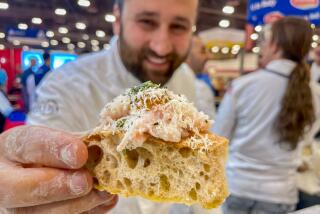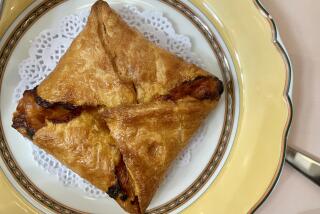Recipe: Nancy Silverton’s olive and rosemary focaccia
Everyone knows Mozza’s Nancy Silverton is famous for her exactitude. Nothing gets by her until it’s absolutely as good as it can be. It took dozens of tries — quite literally — before the Test Kitchen nailed this recipe for her focaccia, but when we finally got it right, we all agreed it is just about the best we’ve tasted. And scores of happy readers agree — it’s one of the most popular subjects on our regular “Our Recipes, Your Kitchen” online feature of reader photographs.
Nancy’s basic focaccia dough
Total time: 3½ hours, plus 12 to 24 hours resting time for the sponge
Servings: Makes 2 (10-inch) focaccia dough rounds
Note: This recipe requires the use of a stand mixer, 2 (10- by 2-inch) round cake pans and a digital kitchen scale. Cake yeast is available at cooking and baking supply stores, as well as at select gourmet markets. The sponge must be started a day in advance.
Focaccia sponge
Scant 1/8 packed teaspoon cake yeast or 1/16 teaspoon active dry yeast
Scant ½ cup (3.71 ounces) water
1/2 cup plus 3 tablespoons (3.04 ounces) bread flour
1. In a small mixing bowl (preferably plastic or ceramic), sprinkle the yeast over the water. Set the bowl aside for a few minutes to give the water time to absorb the yeast. Using a wooden spoon, stir in the bread flour until all of the ingredients are thoroughly combined.
2. Cover the bowl tightly with a sheet of plastic wrap, then tightly wrap another piece of plastic wrap or twine around the perimeter of the bowl to further seal the bowl.
3. Set the bowl aside at room temperature (ideally 68 to 70 degrees) until the sponge becomes bubbly and thick, like the consistency of wallpaper paste (thicker than pancake batter but thinner than dough), 12 to 24 hours.
Focaccia dough
1 1/4 cups plus 2 tablespoons (11.04 ounces) water
1/2 cup plus scant 1 tablespoon (0.39 ounce) olive oil, divided
Focaccia sponge
2 packed tablespoons plus ¼ packed teaspoon (0.39 ounce) fresh cake yeast or 1 3/4 teaspoons (0.195 ounce) active dry yeast
2 tablespoons plus ¾ teaspoon (0.56 ounce) rye flour
3 1/3 to 3 2/3 cups (15 to 16.45 ounces) bread flour, more if needed
1 tablespoon (0.39 ounce) kosher salt
1. About 3½ hours before you are ready to bake the focaccia, place the water, scant tablespoon olive oil and sponge in the bowl of a stand mixer. Fit the mixer with a dough hook and, over low speed, add the yeast, rye flour and 15 ounces (3 1/3 cups) bread flour. Mix the ingredients over low speed for 2 minutes to thoroughly combine and form the dough.
2. With the mixer running, slowly add the salt, then increase the speed to medium. Continue mixing the dough until it is smooth and well-formed, and starts to pull away from the bowl, 6 to 8 minutes. Note that the dough will not pull so much that it “cleans” the bowl, but if the dough is too sticky and is not pulling away from the sides of the bowl at all, add a little more bread flour (a spoonful as needed at a time) to achieve the right consistency.
3. While the dough is mixing, lightly grease a bowl large enough to hold the dough when it doubles in size with olive oil. When the dough is ready, turn it out of the mixer into the oiled bowl. Wrap the dough tightly in plastic wrap and tightly wrap the perimeter of the bowl with kitchen twine or another piece of plastic wrap to further seal the bowl. Set the dough aside at room temperature (ideally 68 to 70 degrees) until doubled, about 1½ hours.
4. Dust the work surface lightly with flour and turn out the dough onto the floured surface. Acting as if the round has four sides, fold the edges of the dough toward the center. Turn the dough over and return it, folded side down, to the bowl. Cover the bowl again with plastic wrap and set it aside at room temperature until it has doubled in volume, 50 minutes to 1 hour. (The dough will be puffy and will feel alive, springy and resistant. It will not collapse under the touch of your fingertips.)
5. Pour ¼ cup olive oil into each of the cake pans, and tilt the pans so the oil coats the bottom evenly. Dust the work surface again lightly with flour and carefully turn the dough out onto the floured surface, taking care not to deflate the dough in the process. Divide the dough into two equal segments, each weighing approximately 18 ounces. Place the dough segments in the prepared cake pans and very gently pull the edges just to obtain a roughly round shape. Cover the pans with a clean dishcloth and set aside at room temperature until relaxed and spread to cover about half of the surface of the pans, about 30 minutes.
Olive and rosemary focaccia
Total time: 1½ hours, plus cooling time
Serves: Makes 1 focaccia; each focaccia yields 8 slices.
1 risen focaccia dough
2 ounces low-moisture mozzarella, cut into generous ½-inch cubes
40 pitted Ascolana olives (or another large pitted green olive)
Olive oil for brushing
20 tufts fresh rosemary
Scant ½ teaspoon Maldon sea salt, or another large flake sea salt
1. Heat the oven to 450 degrees. Remove the dishcloth from the top of one of the focaccias and, using your fingertips, gently tap down on the focaccia with about 5 light strokes to nudge it toward the edge of the pan; it still might not reach the edges, but don’t worry.
2. One at a time, push the mozzarella cubes into the focaccia dough while simultaneously pushing outward to encourage the dough toward the edge of the pan, arranging the cubes evenly over the surface of the dough and pressing them so deep they are almost flush with its surface.
3. Do the same with the olives, arranging them in circular rows between the cheese cubes and pressing them down into the dough and slightly outward.
4. Brush the surface generously with olive oil, then press the rosemary tufts into the dough. Sprinkle over the sea salt. Set the focaccia aside until it is risen and puffed around the toppings, about 30 minutes.
5. Place the focaccia on the center rack of the oven and bake until crisp and golden-brown, 30 to 40 minutes. The focaccia should have risen almost to the top of the pan, and the cheese will be crisp and browned.
6. Move the pan to the bottom of the oven and continue to bake until the bottom crust of the focaccia is deep golden and crisp to the touch, about 5 minutes more.
7. Remove the pan from the oven and remove the focaccia from the pan to a wire rack (use a fork to gently lift and slide the focaccia out of the pan, careful of any hot oil that may still be at the bottom of the pan). Brush the surface of the focaccia once more with olive oil. Set the focaccia aside to cool slightly — or as long as you can resist it.
8. Transfer the focaccia to a cutting board. Halve the focaccia using a long knife, then cut one-half into 4 wedges (don’t cut the other half until you are ready to eat it).
Each slice: 213 calories; 5 grams protein; 25 grams carbohydrates; 1 gram fiber; 10 grams fat; 2 grams saturated fat; 3 mg cholesterol; 0 sugar; 470 mg sodium.
More to Read
Eat your way across L.A.
Get our weekly Tasting Notes newsletter for reviews, news and more.
You may occasionally receive promotional content from the Los Angeles Times.








